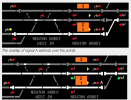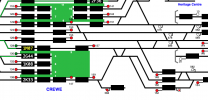To the uninitiated, can someone please explain what the term "Warner" means?
To my understanding, and I'm more than happy to be corrected especially if I am imprecise, a "warner route" set from a signal (such as CE 154) to the next signal (such as CE 148, which would be the route from the up Manchester line to Crewe platform 6) is a route set when a
reduced short restricted overlap exists at the next signal. In this case, the first signal is held at red until the track circuit immediately before it is occupied, so that when it does clear the driver is aware and proceeds with caution.
From what I had experienced at Crewe, the same "warner" arrangement had appeared to be in use when the route was set from CE 154 to CE 150, in other words the more "direct" route from the up Manchester line to platform 5.
I attach a diagram from the SimSig web site (
https://www.simsig.co.uk/Forum/ThreadView/37633) showing the difference between a normal route (first example) and a warner route (second example) set between two signals, and the difference in the overlap at the second signal as a result.
In case it aids understanding also, I also attach a diagram of the layout and signals at Crewe (from Open Train times,
https://www.opentraintimes.com/maps/signalling/crewe) which shows some of the signals discussed in this thread.
The other term that has been used here is "Temporary Approach Control Link" or "TACL". Again, I'm happy to be corrected, but my research leads me to understand that TACL can be set on a signal (such as CE 154, or perhaps on specific routes from a signal) by a "technician" who sets up the signalling system, in other words it's not something that the signaller can control. By its name, it's clearly meant to be "temporary" and can be used during commissioning of signalling systems when perhaps not everything is in place but there's a need to open the railway anyway. TACL being set causes the signal to act as a "warner" signal in being held at red until the approach berth track is occupied by the arriving train.
I think the implication here
might be that "TACL" had been set on CE 154 for quite some time now, for some perfectly good reason, which led to the behaviour which some of us had observed. Indeed, this is what post 6 in this thread by
Signal Head has already said, I believe.


